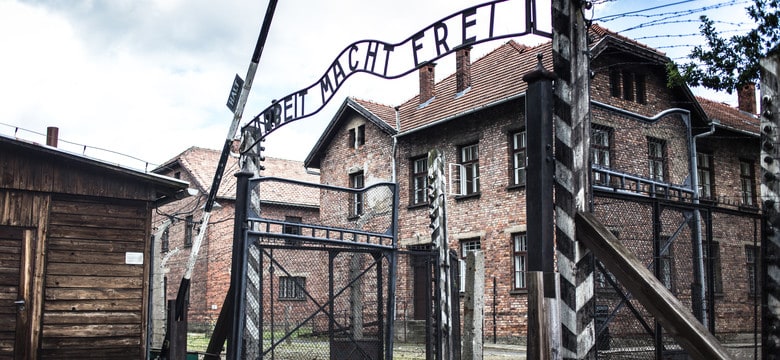On 14th June 1940 the first transport of prisoners, consisting of 728 Polish men, arrived to KL Auschwitz from Tarnow prison. Poles were the first victims of this concentration camp, and the reason Germans created it.
In Poland, 14th June is the annual National Remembrance Day of the Victims of the German Nazi Concentration and Death Camps.
The idea for a concentration camp near the German-occupied town of Oświęcim, on the border of Silesia and Lesser Poland, came from SS-Oberführer Arpad Wigand. Wigand was responsible for state security in the then-German city of Breslau (Wrocław) in late 1939. He was concerned about overflowing prisons in Upper Silesia and Zagłębie Dąbrowskie. Polish resistance had been intensifying and this could only be thwarted by mass arrests. Around the same time, German authorities changed the town’s name from Oświęcim to Auschwitz.
Wigand suggested repurposing Polish army barracks to open the camp without delay. The secluded area was perfect for further expansion and a nearby train line connected Silesia with the General Governorate for the Occupied Polish Region. The order to commence works came from Heinrich Himmler, head of the SS, on 28 April 1940, and was implemented by SS Rudolf Höss, who would later oversee the camp.
Three weeks after Himmler’s order, on 20 May 1940, SS Officer Gerhard Palitzsch brought 30 German non-political prisoners from KL Sachsenhausen near Berlin to KL Auschwitz. They were tattooed with camp numbers 1-30. These criminals became the first cohort of middle management at KL Auschwitz.
KL Auschwitz was inaugurated on 14 June 1940 when the first transport of political prisoners arrived. These were the Poles transferred from Tarnow prison by German security command in Cracow. This transport included prisoners of war from the 1939 September campaign, captured on their way to Hungary, as well as members of the Polish resistance, university and high school students, and a handful of Polish Jews. The prisoners arrived on an ordinary passenger train.
Bogumił Antoniewicz, a survivor from the first transport, reported that the majority were young, well under 50. They came from all social classes and backgrounds. There were students, former soldiers, intelligentsia, aristocrats and peasants. There were also a few Jews. He did not remember seeing any priests, though another survivor recalled that “amongst us were monks, priests and Jews”.
As the train from Tarnow stopped in Cracow, the prisoners heard the news about the of surrender of Paris. Prisoner Jerzy Bielecki recalled: “This moment stuck in my head, when the train rolled into Cracow station. We heard from the loudspeakers that Paris had just fallen. We felt horrible. Desperate moments. The Germans were celebrating.”
Kazimierz Albin recalls the welcome speech by the commander of KL Auschwitz, Hauptsturmführer Karl Fritzsch.
“This is Konzentrationslager Auschwitz.,” announced Fritzsch. “As elements hostile to the German nation, you will be detained here until the end of the war. Any signs of mutiny or disobedience will be severely punished. The penalty for resistance or attempted escape is death. If you are young and healthy you may survive up to three months. The only exit is though the crematorium chimney”.
After that, the prisoners were tattooed with camp numbers 31-758 and moved to the building of the former Polish Tobacco Monopoly. This is located next to what is now the Auschwitz Museum and Witold Pilecki’s School. The other buildings of KL Auschwitz were not ready yet.
Camp inmate number 31 was Stanisław Ryniak. After the war, he speculated: “I’ve often wondered why I got 31, the first Polish political number. We knew that 1-31 were German criminals. Was my name on top of the list, or was it pure coincidence?”
Of the 728 prisoners deported on that day, 298 survived the war, 272 died, and we do not know the fate of the other 158. Only one is still alive in 2021 – Kazimierz Albin.
The extermination of the Poles in KL Auschwitz served two purposes. The first was to terrorise the local population. The second, longer-term objective was to depopulate the future “German living space”, as Polish territories were designated for eventual germanisation.
Initially ethnic Poles were the predominant inmates. By midway through 1942 their numbers were matched by Jews, brought to KL Auschwitz from all over Europe. From 1943 Jews were the largest group in the camp.
The profile of Polish prisoners was varied. Many were detained because of their leadership potential: professors, artists, politicians, clergy, doctors, teachers, lawyers, engineers, army officers. Another group had been arrested at random on Polish streets in a practice known as a “łapanka” – a Nazi German tool of terrorising the urban populations. Then there were people forcibly removed from Zamojszczyzna (1942-43) and later from Warsaw during the 1944 uprising. A number of local residents from Oświęcim were also incarcerated.
In total, approximately 150,000 ethic Poles were transported to KL Auschwitz. Around half of this number survived.
KL Auschwitz was the main place of torment for Polish patriots from Upper Silesia, Cieszyn, Zagłębie, Chrzanów, Oświęcim and Żywiec regions. Of the 27,380 ethnic Polish prisoners from Upper Silesia (this number does not include Jews or Gypsies, who were recorded separately) only 9,054 survived until the end of the war. Of the rest, historians were able to establish the names of 7,969. The other 10,357 Poles remain unnamed. They are known only by the camp numbers detailed in Nazi records.
Nowhere is the dehumanising practice of numbering people more apparent than in KL Auschwitz court records. This farce of a court was run by the head of Gestapo from Katowice. While 3,118 Upper Silesians were sentenced to death by this “court” and executed, only 1,830 men and women are identified by name. The rest we only know by their camp numbers.
Tłum. Jan Iwanik
[Wróć do tekstu w języku polskim]
Podoba Ci się to co robimy? Wesprzyj projekt Magna Polonia!






